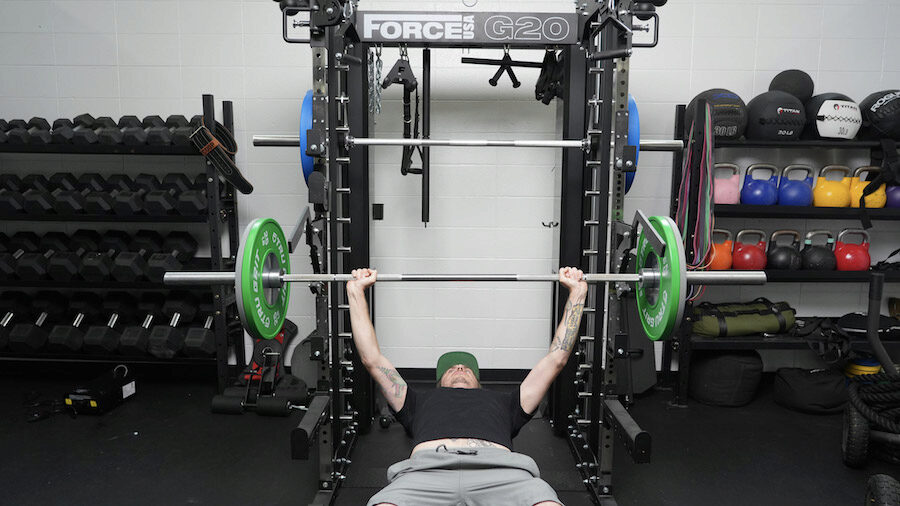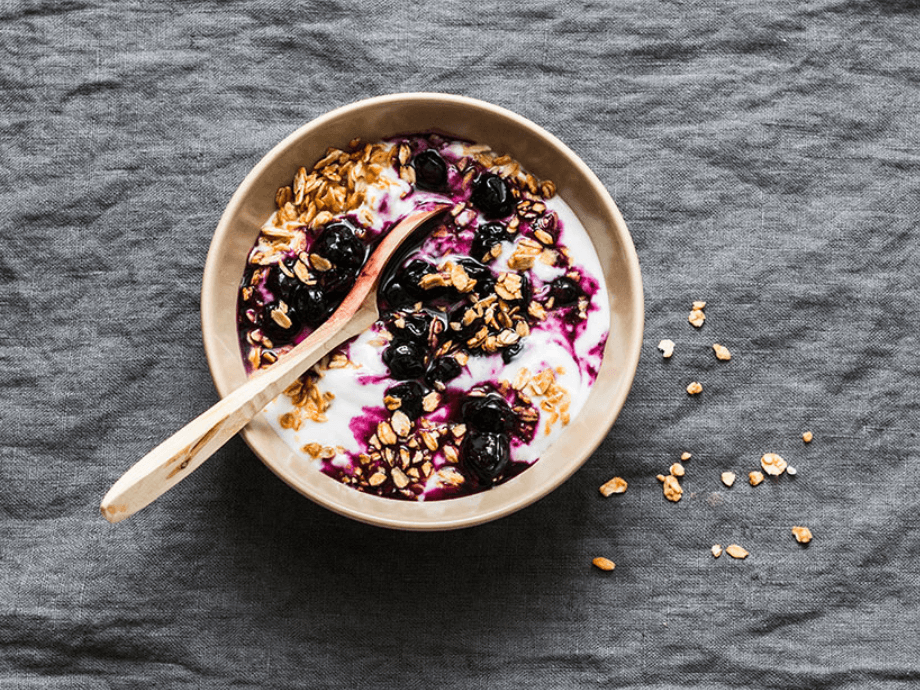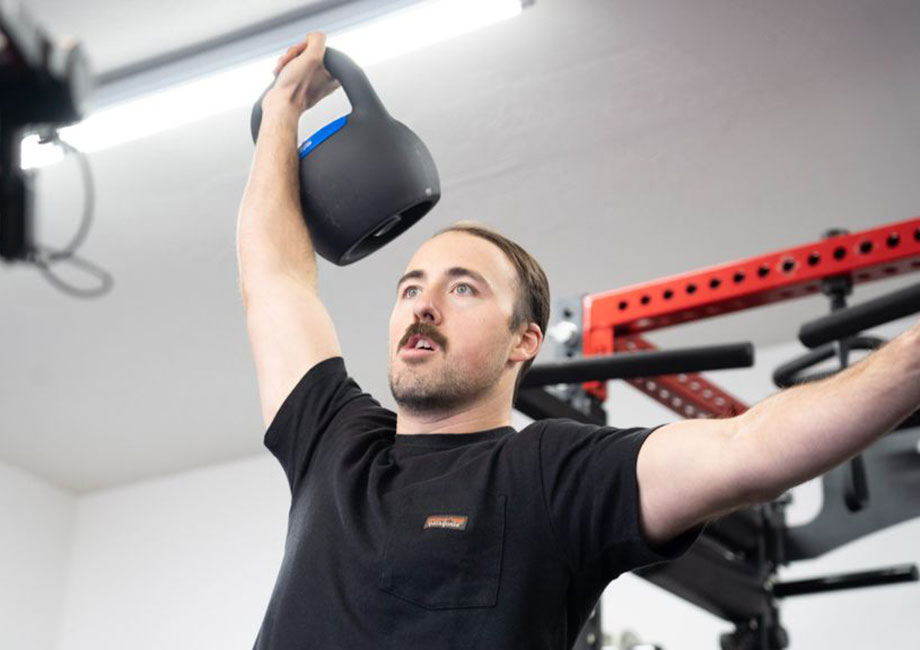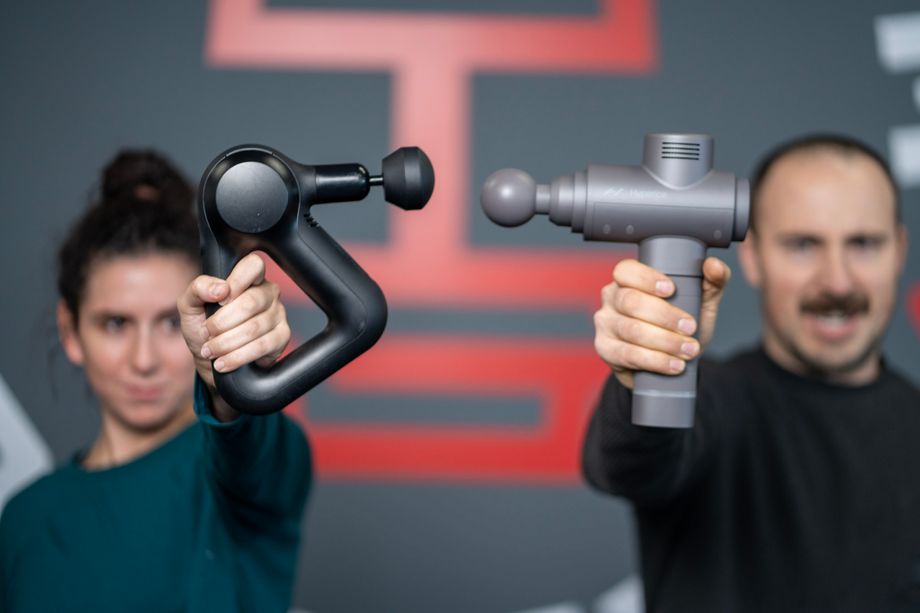Anyone who’s stepped foot in a gym has seen the bench press in action. For many lifters, it’s the cornerstone of a strength training program along with the other “Big Three” lifts, the back squat and the deadlift, and essential for building a hulking upper body.
Most people know the bench press hits your chest muscles, but what else is activated during the movement?
What muscles does the bench press work, really?
Today, we’re diving deep into one of the most popular compound exercises out there to clarify what muscle groups are activated during the bench press, as well as the benefits of incorporating the bench press into your workout routine.
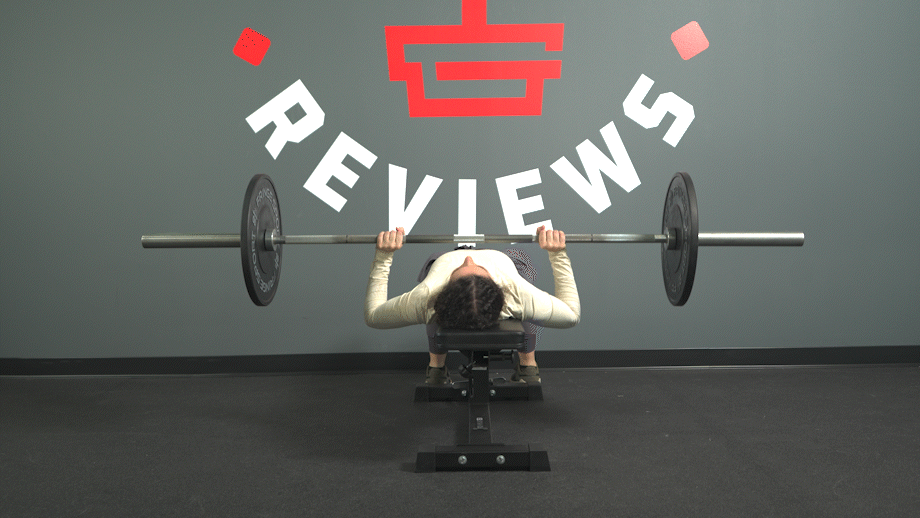
Defining the Bench Press
Before we dive in, what is and how do you do the bench press?
For the purposes of our review, we’re going to specifically discuss the flat bench press, or standard bench press, which involves lying on a flat bench and pushing weights straight up and away from the body.
The bench press is traditionally completed using a barbell, but dumbbells also make a fine substitute. Variations may be performed using different grip widths, like the close grip bench press which features a narrow grip on the barbell, but the standard barbell bench press requires hands shoulder-width apart and the bar positioned directly over the chest.
There are several bench press variations, like the incline bench press and decline bench press which involve raising or lowering the bench to a 30-degree angle respectively, which provide similar muscle activation.
To keep things simple today, we’re focusing mostly on the standard flat bench press.
Bench Press: Muscles Worked
As a compound exercise, the bench press targets numerous muscles in the upper body, but lifters should receive some activation in other areas of the body as well.
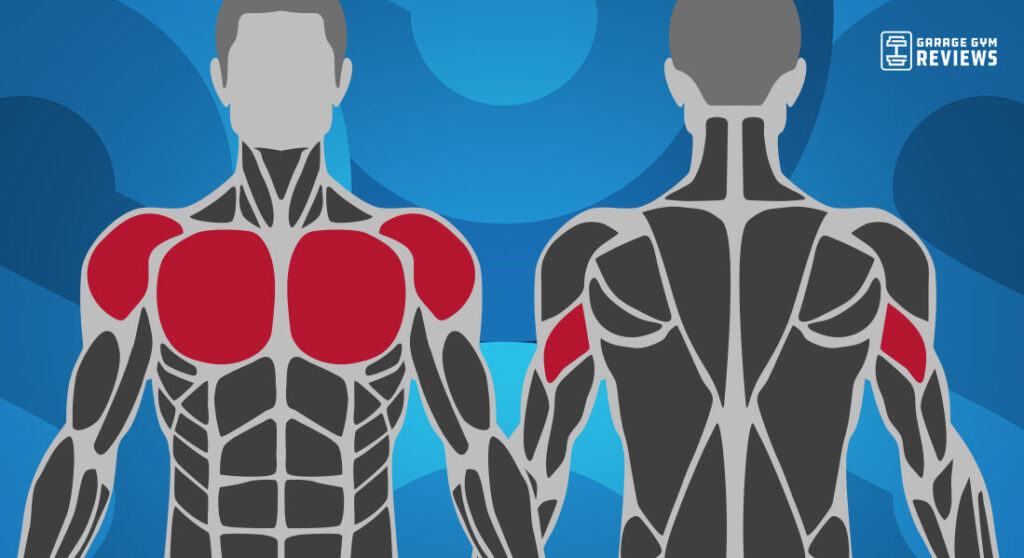
Primary Movers
The prime movers of the bench press are your chest muscles (hence why some people call this a chest press), your triceps, and the front of your shoulder muscles, or the anterior deltoids. These muscles are most responsible for generating the force required to push those heavy weights off your chest during the bench press and, therefore, receive the most muscle activation as a result.
- Pectoralis major: The pectoralis major allows you to push the weight off your chest and back to the starting position during the bench press. You derive most of your bench press strength from the pectoralis major, making it the primary mover in this exercise.
- Triceps brachii: If you can’t push the weight off your chest, you’ll never actually complete a single bench press rep in the first place.You’ll need all three triceps brachii working to extend your elbow and achieve that perfect lock out position after each rep.
- Pectoralis minor: The pectoralis minor, due to its location behind your sternum, is integral in stabilizing the shoulder, and assists the scapula in depression, abduction, protraction, and internal rotation within the shoulder joint. You receive great pectoralis minor activation when your shoulder blades lift off the bench slightly after each rep.
- Anterior deltoid: Any task that involves reaching your arms out in front of your body or pushing an object away will involve your anterior deltoids, or your front delts. These shoulder muscles sit in close proximity to your upper chest muscles, and receive excellent activation during the bench press exercise.
Of the prime movers, which muscles receive the most activation?
A 2017 systematic review published in PLOS ONE1 reviewed data from fourteen relevant studies and concluded that the “triceps brachii and pectoralis major muscles were found to have similar activity during the [bench press], which was significantly higher than the activity of the anterior deltoid,” meaning all of the prime mover muscle groups contribute to a bench press, but your chest and triceps enjoy the lion’s share of the work, and subsequent gains.
However, a 2017 study published in the Journal of Strength and Conditioning Research2 observed that role shift as study participants lifted closer to their one-rep max, with “the pectoralis major [changing] from being the prime mover to being the supportive prime mover” and “the role of the prime mover is taken on by the deltoideus anterior.”
Secondary Movers
So, you’re mostly hitting the chest muscles, triceps, and the front of your shoulders during the bench press, but that’s not where the muscle activation ends. The body recruits several secondary movers to assist in the pushing movement of the bench press.
- Biceps brachii: You’re not going to build bulging biceps doing bench presses, but there is activation. in the biceps brachii and it assists in stabilizing the humerus, or upper arm bone, within the shoulder joint. A 1989 study published in Clinical Orthopaedics and Related Research3 observed this effect specifically “during powerful elbow flexion and forearm supination,” which are two conditions that exist during a heavy bench press.
- Serratus anterior: The serratus anterior muscles are fan-shaped muscles below your pectoral muscles on either side of your upper abdominals. They’re responsible for bringing your shoulder blades forward, an action you might perform when throwing a punch, performing a push-up, or pushing a barbell during the bench press.
- Trapezius and rhomboids: Your upper back muscles, specifically the traps and rhomboids, work during the bench press as well to help stabilize and maintain your positioning. They work to retract the scapula and push the chest forward.
- Forearms: Any time you grip a barbell or dumbbell, you’ll engage the wrist flexors and extensors of the forearm to maintain that grip. The bench press is no exception here.
- Latissimus dorsi: While a study published in the Journal of Strength and Conditioning Research2 observed electromyographic activity in the lats back in 2017, a 2022 study published in the Journal of Sports Sciences4 expanded on their role. The study found that the “arch technique,” which is a powerlifting technique that involves using a dramatic arch in your back during the bench press, “increased latissimus dorsi mean and peak activation,” and concluded the technique serves as a viable way to minimize “the amount of time spent in the ‘sticking region,’ where most lift efforts fail.
While your pectoral muscles, triceps, and front delts do the real heavy lifting during the bench press exercise, your body also recruits the biceps, serratus anterior, upper back muscles, forearms, and lats to help get the job done.
Tertiary Movers or Supporting Muscles
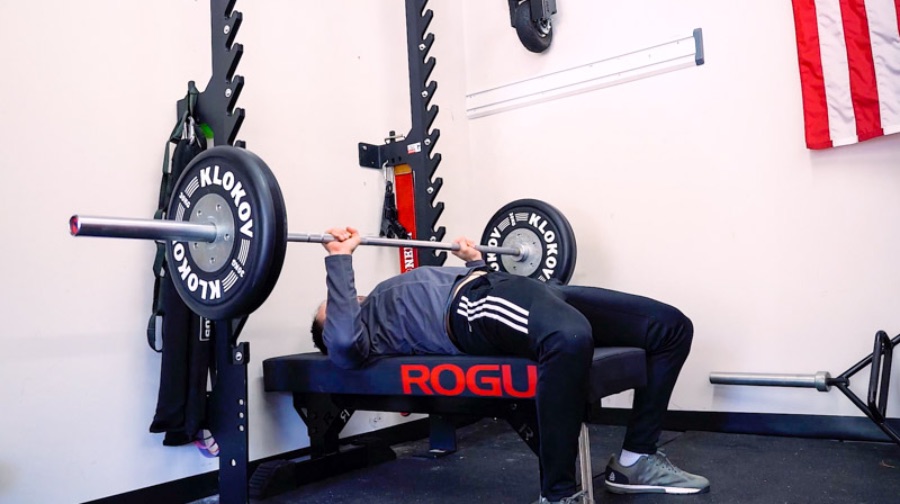
The bench press targets many muscles in your upper body, but do we get activation anywhere else? The following muscles are tertiary movers and supporting muscles that help you maintain proper form during the movement.
- Core muscles: A 2007 study published in the Journal of Strength and Conditioning Research5 observed an “increase activation of the core stabilizing musculature,” specifically of the “latissimus dorsi, rectus abdominus, internal obliques, erector spinae, and soleus,” when the bench press was performed in “a progressively unstable environment.”
- Glutes: As it turns out, your derriere plays a key role in stabilizing the hips and pelvis during the bench press, especially when going heavy.
- Quadriceps: The standard bench press will recruit your leg muscles, like the quadriceps, to stabilize the trunk during the lift.
At a glance, it might seem your lower body and core have very little to do with the bench press, but their function in stabilizing your torso is essential to performing the lift with minimal risk of injury.
Benefits of Bench Press
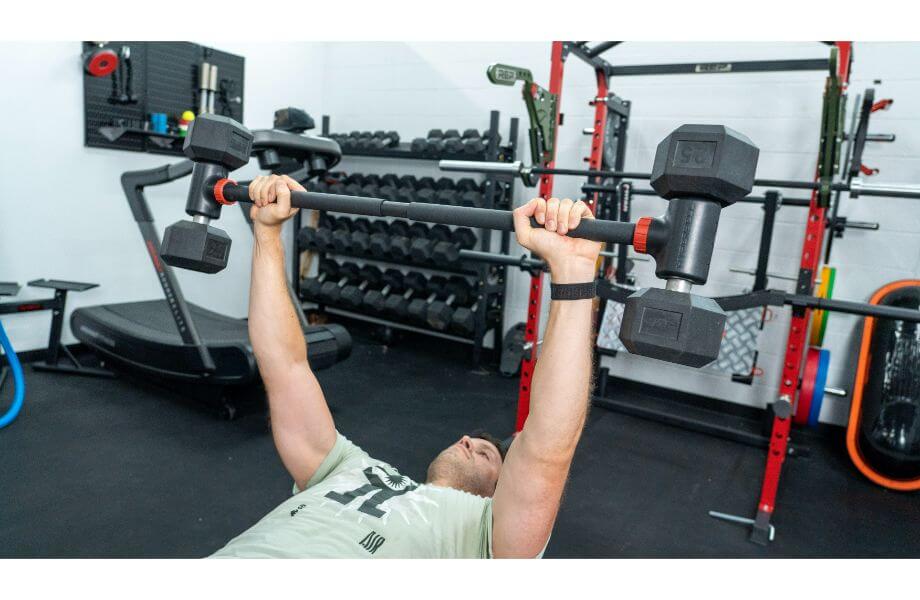
There are many benefits associated with the bench press, explaining why it’s one of the most popular weightlifting exercises today.
Regular bench pressing, especially if following the principles of progressive overloading, should yield both strength gains and hypertrophy of the chest, shoulders, and triceps. As with most resistance training, the bench press also improves muscular endurance, improves bone density, and assists in weight loss, too.
The bench press also helps improve explosive power in the upper body, which translates into activities and sports that require pushing or throwing movement. In fact, a 2013 study published in the Journal of Strength and Conditioning Research6 measured this “observed increase in upper-body power” in professional rugby players after they performed sets of the bench press. The study determined that “an upper-body ballistic movement,” like the bench press, “provides an effective strategy for increasing [peak power output].”
Who Should Do Bench Press?
So, who should work bench presses into their workout routine?
Anyone enthusiastic about fitness can benefit from the strength gains, hypertrophy, calorie burning properties, and improvements to muscular endurance and bone health.
Athletes, especially those who rely on upper body strength including football, basketball, and volleyball players, can benefit from bench pressing regularly. Bodybuilders also will benefit immensely from regular bench pressing, as the lifts’ ability to help build muscle mass and size in the chest help them cultivate the hulking physique required to compete in the sport.
Who Shouldn’t Do Bench Press?
Although most individuals could find value in working sets of the bench press into their routine, it’s not for everyone.
Individuals who previously suffered or are currently recovering from injuries like rotator cuff tears and pec tears should exercise extreme caution when bench pressing or avoid it altogether. Those experiencing chronic lower back and shoulder pain might be better off steering clear of the bench press, too. Always consult a doctor or physical therapist before engaging in any activity that could aggravate an existing injury or contribute to further injury.
Bench press beginners who balk at the sight of a heavy barbell on the rack might also choose to avoid the bench press. We do recommend these individuals work with a spotter or certified personal trainer to build familiarity with the bench press, develop a strong foundation, and reap the rewards of this excellent exercise, but it’s by no means a requirement. There are many other exercises that could help bench press averse individuals reach their fitness goals.
In fact, a 2017 study published in the Journal of Exercise Science and Fitness7 observed that the good ol’ push-up was “effective for muscle hypertrophy and strength gain” when compared with a “40% 1RM bench press” over an 8-week duration.
Final Thoughts: What Muscles Does The Bench Press Work?
The bench press is a compound exercise that recruits many different muscle groups to move the barbell, or dumbbells, through the full range of motion.
- The prime movers of the bench press include the pectoralis major, triceps brachii, pectoralis minor, and anterior deltoids.
- The secondary movers include the biceps brachii, trapezius, rhomboids, forearms, and latissimus dorsi.
- The tertiary movers or supporting muscles include the core muscles, glutes, and quadriceps.
As a compound exercise, the bench press provides incredible activation to most muscle groups of the upper body, and additional activation in the core and lower body muscle groups as well. Because of this, it is invaluable for building strength, encouraging muscle growth, and enhancing general fitness.
Overall, the bench press works a ton of muscles, and therefore makes an excellent addition to any comprehensive workout program.
Q&A: What Muscles Does The Bench Press Work?
Do bench presses work biceps?
Bench presses recruit the biceps to some degree, but they are predominantly used for shoulder stabilization. For better bicep gains, we recommend exercises that target the biceps specifically like bicep curls and chin-ups instead of a chest exercise like the bench press.
RELATED: Try This Cable Biceps Workout For Bigger, Stronger Arms
Can you build muscle with just bench press?
The bench press is a great tool for stimulating muscle growth in the upper body, but you’ll need more than that if you’re looking to cultivate an all-around muscular physique. You’ll get better results incorporating numerous complementary exercises when building muscle mass, and targeting different muscle groups with exercises like the back squat and deadlift, too.
For the best results, consider working with a qualified personal trainer.
Can bench press get you abs?
The bench press recruits core muscles to act as stabilizers and help you maintain proper form through the movement, but it is not a direct abdominal exercise. Exercises that specifically target the abdominals like planks, crunches, leg raises, and Russian twists will be more beneficial towards helping you get abs than the bench press.
Then again, what’s better than a workout program engineered to help you get abs? A diet that prioritizes proper nutrition. “Abs are made in the kitchen, not the gym.”
RELATED: The 12 Best Ab Exercises To Build Core Strength, According To A CPT
What are the disadvantages of bench presses?
There are many advantages to the bench press, but it’s not without drawbacks. For example, if the exercise is not performed correctly, the bench press puts significant strain on the shoulder joint, chest, and triceps, leading to injuries like rotator cuff tears, pec tears, and shoulder impingement.
In addition, the lift places a person in a precarious position. If you’re trying to go heavy or are a beginner just learning how to bench press, you should use a spotter or a lift inside a power cage with safety devices engaged.
References
1. Stastny P, Gołaś A, Blazek D, et al. A systematic review of surface electromyography analyses of the bench press movement task. PLoS One. 2017;12(2):e0171632. Published 2017 Feb 7. doi:10.1371/journal.pone.0171632
2. Król, Henryk; Gołaś, Artur. Effect of Barbell Weight on the Structure of the Flat Bench Press. Journal of Strength and Conditioning Research 31(5):p 1321-1337, May 2017. | DOI: 10.1519/JSC.0000000000001816
3. Kumar VP, Satku K, Balasubramaniam P. The role of the long head of biceps brachii in the stabilization of the head of the humerus. Clin Orthop Relat Res. 1989;(244):172-175.
4. Cudlip AC, Maciukiewicz JM, Pinto BL, Dickerson CR. Upper extremity muscle activity and joint loading changes between the standard and powerlifting bench press techniques. J Sports Sci. 2022;40(9):1055-1063. doi:10.1080/02640414.2022.2046937
5. Norwood JT, Anderson GS, Gaetz MB, Twist PW. Electromyographic activity of the trunk stabilizers during stable and unstable bench press. J Strength Cond Res. 2007;21(2):343-347. doi:10.1519/R-17435.1
6. West, Daniel J.; Cunningham, Daniel J.; Crewther, Blair T.; Cook, Christian J.; Kilduff, Liam P.. Influence of Ballistic Bench Press on Upper Body Power Output in Professional Rugby Players. Journal of Strength and Conditioning Research. 27(8):p 2282-2287, August 2013. | DOI: 10.1519/JSC.0b013e31827de6f1
7. Kikuchi N, Nakazato K. Low-load bench press and push-up induce similar muscle hypertrophy and strength gain. J Exerc Sci Fit. 2017;15(1):37-42. doi:10.1016/j.jesf.2017.06.003


